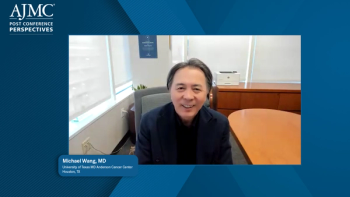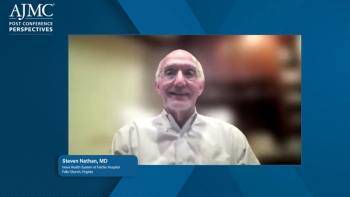
From “Super Skeptical” Beginnings, a New Immune-Modulatory Vaccine Awaits Phase 3 Results
Key Takeaways
- IO Biotech's vaccines activate T cells to modify the tumor microenvironment, targeting both cancer and immune-suppressive cells.
- The T-win technology combines IO102 and IO103, targeting IDO and PD-L1, achieving durable responses with reduced toxicity.
IO Biotech's first-in-class vaccine performs double duty, killing cancer cells and enhancing the tumor microenvironment. A phase 3 trial is on track to release results this fall.
Data exploring a new type of tumor-fighting vaccine, presented last week at the American Association for Cancer Research (AACR), hint at game-changing news that could come by the end of the year.
IO Biotech, a Copenhagen-based developer of first-in-class immune modulating cancer vaccines, shared a pair of abstracts that shed light on how these dual-acting therapies work and showed their potential in multiple solid tumor cancers.1,2 Unlike older therapeutic vaccines, including some customized agents, these off-the-shelf vaccines activate T cells that upend the tumor microenvironment (TME), fighting cancer in 2 ways: they kill tumors cells and set loose effector T cells to create an anti-tumor, proinflammatory TME.
It’s an approach that IO Biotech cofounder and scientific adviser, Mads Hald Andersen, DMSc, PhD, said has overcome doubters, with IO Biotech recently listed as one of
“It’s a whole new [mechanism of action],” Andersen said during an interview at AACR with The American Journal of Managed Care (AJMC). “It has been underway for 15 years. We did the first discoveries and moved slowly from phase 1 trials, and everybody was super skeptical.”
IO Biotech’s technology, called T-win, works by delivering peptide epitopes to interact with antigens and launch the dual action. The lead agent pairs IO102, targeting indoleamine 2,3-dioxygenase (IDO), with IO103, targeting PD-L1. The combination, also known as imsapepimut and etimupepimut adjuvanted and trademarked Cylembio, has received FDA Breakthrough Therapy designation.4,5 A phase 3 trial involving 407 patients, combining IO102/IO103 and pembrolizumab (Keytruda) in metastatic melanoma, will read out in the third quarter of 2025 (NCT05155254). The company expects to file a Biologics License Application with FDA by year’s end.5
This comes more than 3 years after promising phase 1/2 data appeared in Nature Medicine;6 in that study (NCT03047928), 30 patients with advanced melanoma received a combination of IO102/IO103 and nivolumab (Opdivo). The study, first presented virtually at the 2020 Congress of the European Society of Medical Oncology,4 met its primary end point of feasibility and safety and showed the combination’s toxicity profile “was comparable to that of nivolumab monotherapy.” The objective response rate (ORR) was 80% (CI, 62.7-90.5), with 43% of patients achieving a complete response (CI, 27.4-60.8). Median progression-free survival (PFS) was 26 months (CI, 15.4-69 months) “and was not reached for responding patients.” Overall survival at 12 months was 81.6% (CI, 61.6-92). Investigators compared these results with data from a matched historical group with advanced melanoma treated with anti-PD-1 therapy—the matched group’s median PFS was 8.3 months.6
What’s more, investigators were able to show that “the IDO- and PD-L1-specific T cells’ mode of action (MOA) is not limited to targeting only cancer cells. We were able to show that vaccine-specific T cell clones also reacted against PD-L1- and IDO-expressing autologous immune cells.”6
How Immune-Modulating Vaccines Work
Andersen explained the difference between traditional cancer vaccines and this new immune-modulatory class. Historically, cancer vaccines have targeted cancer cells or cancer mutations only. With these new vaccines, he said, “When we are generating an immune response, we are vaccinating against the whole tumor environment, so not just the cancer cells, but also the immune suppressive cells.”
The vaccines “kill the tumor cells, but they also kill immune suppressive cells,” he continued. This process essentially reprograms the TME to go after the cancer instead of allowing a tumor to grow. “By vaccinating with an immune-modulatory vaccine, you can change the microenvironment from being immune hostile to immune friendly.”
Early on, Andersen said, skeptics took issue with the vaccines’ deployment of self-antigens, components of an organism’s own cells that a patient’s immune system “sees” as belonging and does not attack. This is opposed to “non-self” antigens that the body recognizes as foreign.
In this case, the T-win technology targets IDO and PD-L1, both proteins produced within the body and expressed by immune-suppressive cells such as T regulatory cells, or Tregs. “These are there even in healthy people and are part of how the immune system is regulated,” Andersen said, noting that other companies have now come around to this approach.
The vaccines achieve more durable responses than anti-PD-1 therapy alone, but they do so without the toxicity seen when anti-PD-1 is combined with anti-CTLA-4 therapy. Although the response rate in advanced melanoma with combined checkpoint inhibitors is about 60%, about half the patients develop severe adverse events (AEs), investigators noted in the Nature Medicine paper.6
Andersen said immune-modulatory vaccines are less toxic because they only target the most immunoexpressive cells. “They do not function where these antigens are not highly expressed. And when these antigens are highly expressed, they have very immunosuppressed environment,” he said. The most commonly reported AEs are site reactions, Jonathan Riess, MD, MS, medical director of Thoracic Oncology, an associate professor of Medicine, Division of Hematology & Oncology, University of California Davis Comprehensive Cancer Center, told AJMC in 2024.7
Unlike doubling down on immunotherapy, Andersen said, “In the vaccine situation, you activate as part of the T cells, not because they have PD-1 on the surface, but because they recognize cells that express PD-1. They can attack them, and they can kill them.”
New Data Presented at AACR
IO Biotech’s abstract on IO102/IO103 used preclinical models to further compare the MOA with that of checkpoint inhibitors, measuring T-cell activity in tumor tissues, spleens, and lymph nodes.1 “Vaccination against IDO1 and PD-L1 induced specific T-cell expansion in splenocytes, associated with reduced tumor growth. In particular, PD-L1 specific T cells were also detected in lymph nodes and tumor infiltrating lymphocytes,” investigators wrote. They were able to confirm T cell stimulation in CD8+ cells and found “distinct immune signatures” that conformed the tumor-fighting qualities of the PD-L1 component or reduced immune suppression in the TME from the IDO1 vaccine component.
“The gene expression changes observed were different from the signatures of anti-PD-L1 and anti-PD1, suggesting a complementary mode of action to those therapeutics,” they wrote.1
A second abstract evaluated the MOA for a different IO Biotech vaccine, IO170. This vaccine is directed at transforming growth factor (TGF)β to induce T cell activation, driving antitumor activity by modulating the TME.2 As the investigators explain, both cancer cells and other TME components, including fibroblasts and blood vessels, “exploit” this pathway as cancer grows. With various mouse models, investigators tested the vaccine against pancreatic adenocarcinoma (PDAC), and in a CRISPR/Cas9-driven model of prostate cancer..
Investigators compared tissue against a control group to confirm T cell expansion and slowing of progression of prostate tumors. “Collectively, treatment with the TGFβ vaccine significantly reduced the total tumor burden, without affecting the body weight and overall welfare of the animals,” they wrote.2
Besides the phase 3 trial, enrollment was completed early for a phase 2 basket trial of Cylembio as a neoadjuvant/adjuvant treatment for patients with resectable melanoma or head and neck cancer. In its March 2025 report on 2024 business highlgihts, company officials said initial data for this trial is expected in the second half of 2025.5
In addition, IO102/IO103 is being studied in non-small cell lung cancer and in metastatic urothelial cancer. Preclinical data for IO112, another immune-modulatory therapeutic vaccine candidate targeting Arginase-1, appeared in the Journal for ImmunoTherapy of Cancer.8 An Investigational New Drug Application for IO112 is expected this year.5
“There is still a significant unmet medical need for new treatment options for patients suffering from advanced melanoma, metastatic head and neck cancer, and metastatic lung cancer,” Mai-Britt Zocca, PhD, President and CEO of IO Biotech, said in a statement on the report. “The full IO Biotech team is proud to be leading the next frontier of immune-oncology with the development of therapeutic cancer vaccines for these and other difficult-to-treat cancers.”5
References
- Chapellier M, Madsen A, Agerholm-Nielsen R, et al. Immune-modulatory therapeutic cancer vaccines against IDO1 and PD-L1 control tumor growth through target specific changes in the tumor microenvironment. Presented at: American Association for Cancer Research, April 25-30, 2025; Chicago IL. Abstract 2241.
- Joseph JV, Bocci M, Hansen UK, et al. A TGFβ-directed immune-modulatory vaccine induces T cell activation and drives antitumor activity by modulating the tumor microenvironment. Presented at: American Association for Cancer Research, April 25-30, 2025; Chicago IL. Abstract 2257.
- IO Biotech named among Fast Company’s world’s most innovative companies of 2025. News release. IO Biotech. March 18, 2025. Accessed May 3, 2025.
https://investors.iobiotech.com/news-events/news/news-details/2025/IO-Biotech-Named-Among-Fast-Companys-Worlds-Most-Innovative-Companies-of-2025/default.aspx - The Food and Drug Administration (FDA) grants IO Biotech breakthrough therapy designation for IO102 and IO103 in combination with anti-PD-1 in unresectable/metastatic melanoma. News release. IO Biotech. December 10, 2020. Accessed May 3, 2025.
https://bit.ly/4jCnvM2 - IO Biotech reports 2024 business highlights. News release. IO Biotech. March 4, 2025. Accessed May 3, 2025.
https://investors.iobiotech.com/news-events/news/news-details/2025/IO-Biotech-Reports-2024-Business-Highlights/default.aspx - Kjeldsen JW, Lorentzen CL, Martinenaite E, et al. A phase 1/2 trial of an immune-modulatory vaccine against IDO/PD-L1 in combination with nivolumab in metastatic melanoma. Nat Med. 2021;27:2212-222. https://doi.org/10.1038/s41591-021-01544-x
- Dr Jonathan Riess on the potential of IO102/IO103 in the cancer vaccine landscape. The American Journal of Managed Care.
https://www.ajmc.com/view/dr-jonathan-riess-on-the-potential-of-io102-io103-the-cancer-vaccine-landscape - Martinenaite E, Lecoq I, Aaboe-Jørgensen M, et al. Arginase-1-specific T cells target and modulate tumor-associated macrophages. J ImmunoTher Cancer. 2025;13::e009930. doi: 10.1136/jitc-2024-009930
Newsletter
Stay ahead of policy, cost, and value—subscribe to AJMC for expert insights at the intersection of clinical care and health economics.






































